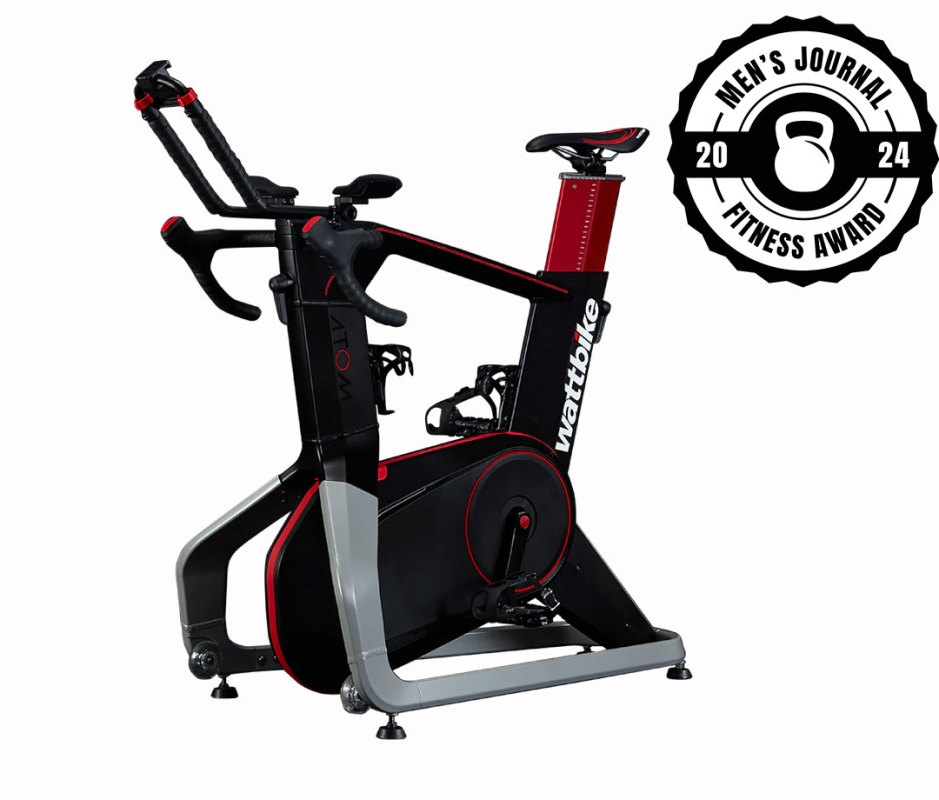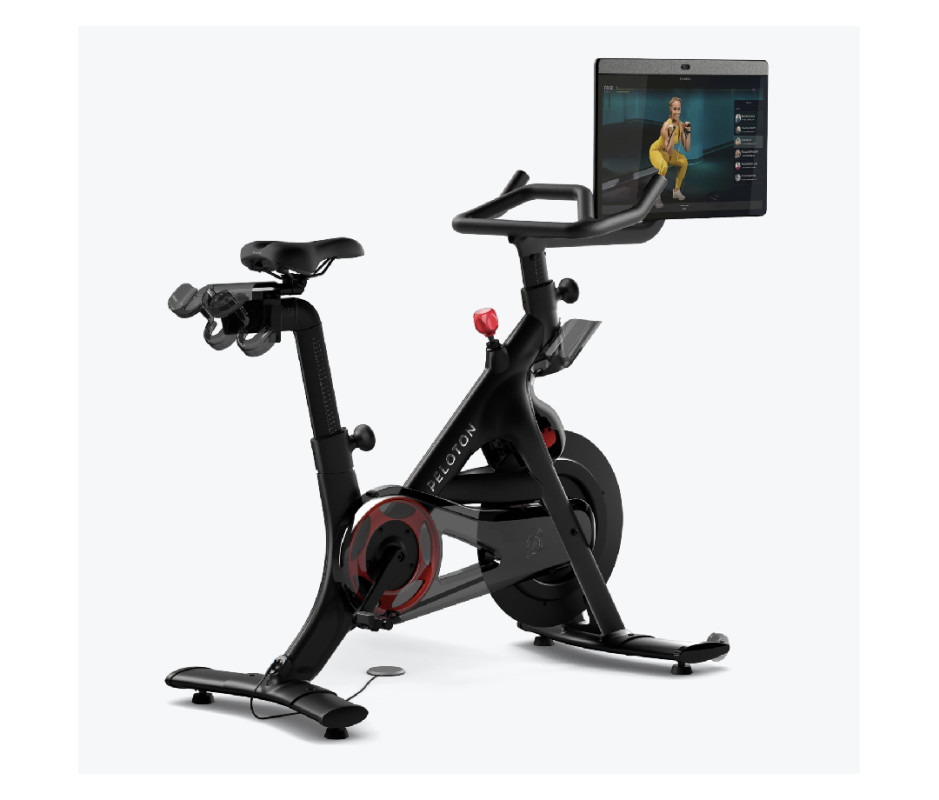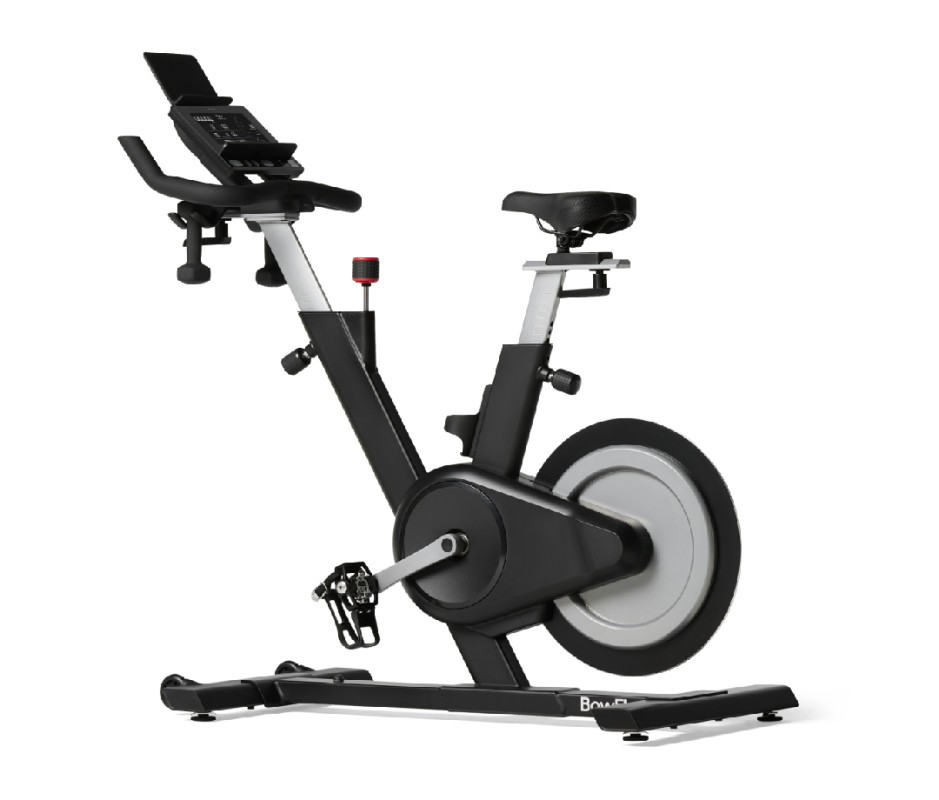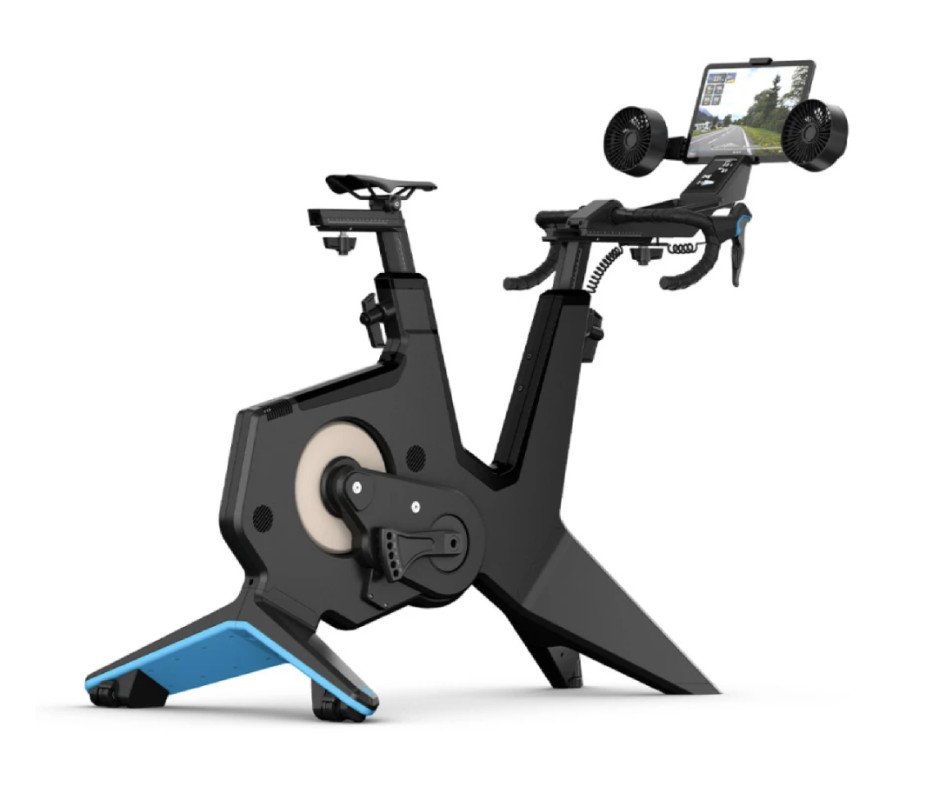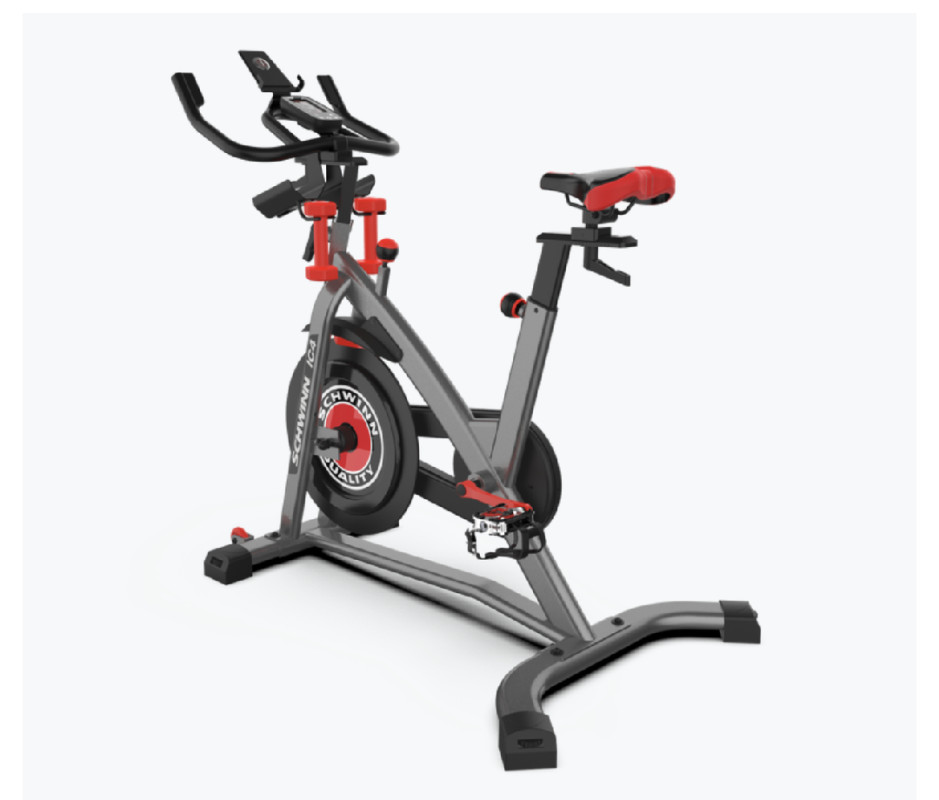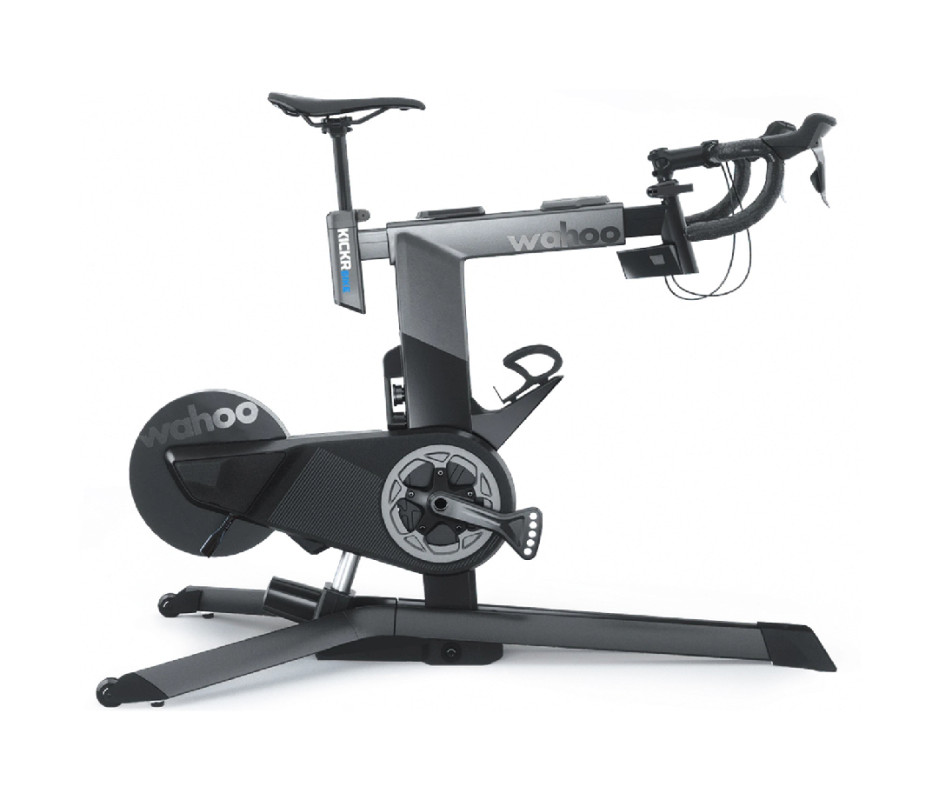Exercise bikes are enjoying a resurgence thanks to a recent explosion in available technology. Unlike their 1990s ancestors, most of today’s stationary indoor exercise bikes immerse you in classes, virtual reality rides, and game-like apps that make riding to nowhere far more fun than in decades past. They also can display and collect a lot of data about your efforts which can help you train smarter and provide real-time feedback that helps keep you engaged with the workouts.
Finding the right exercise bike (and the accompanying software to enhance your rides) can be a powerful way to fit fitness into a busy life when weather, time, and circumstances conspire to push your workouts into that eternal “tomorrow.” Picking a bike that meets your goals and needs will also ensure you keep coming back for workouts—lest it be relegated to acting as an expensive drying rack. Which is why our top pick for best overall home exercise bike is the Wattbike Atom. It’s a well-built bike that’s an all-around great smart trainer that includes compatibility with lots of apps.
Justin Park
Related: 20 Best Exercises for Every Muscle, According to Science
For these reviews, we tested several of the most popular stationary exercise bikes in a range of prices and styles to share the pros and cons of each. Read on to learn more about the best indoor exercise bikes available today and find the trainer that best fits your budget and workout preferences so it gets covered in sweat instead of dust.
Men’s Journal aims to feature only the best products and services. We update when possible, but deals expire and prices can change. If you buy something via one of our links, we may earn a commission.
Best Overall Exercise Bike: Wattbike Atom
Courtesy Image
When researching indoor cycling bikes for this article, the Wattbike wasn’t on my radar at first. But as I talked to serious cyclists, the Wattbike kept coming up as a detail-oriented bike with a mid-range price beloved by racers and athletes for its serious training applications. Despite its “hardcore” rep, the bike itself is fairly unassuming and looks similar to other higher-end indoor trainers with road bike style handlebars, a performance seat, and lots of fit adjustment points. It’s also one of the few bikes that comes fully assembled which cuts out a huge hassle on the front end of your indoor bike experience. Fitting the bike is easy and the seat and handlebars move in several planes to dial in a comfortable fit—key to enjoying all those miles you’re going to log.
This is a fairly straightforward bike in terms of bells and whistles. Incline adjusts virtually, there are no Bluetooth fans, no built-in screen, and no little dumbbells hanging from the frame. The Atom sets itself apart by focusing on metrics and ride feel instead, making it a straightforward training tool for athletes and recreational riders.
The free Wattbike Hub app just looks science-y and I found the pedal efficiency visual display entrancing and addictive. Even though I’m a rider chasing fun and not at all obsessed with efficiency and KOMs, I found myself immediately battling to smooth my pedal strokes and balance right, left, push, and pull and could see how this gamification of technique could translate to real-world results. The Hub app also includes several benchmark tests that make it easy to get baseline fitness metrics for yourself and then check your progress as you train by taking the tests again.
While the accuracy and training features appeal to serious riders, the bike easily pairs with popular studio apps like Peloton and virtual ride apps such as Zwift, so it’s great for sharing with household members with different indoor training styles. There’s no built-in screen, but the tablet/phone holder makes it straightforward to get set up for virtual rides.
Even if you’re not going to use 100 percent of its capabilities, the Wattbike is a great all-around smart trainer that’s a less expensive option for riders that want accuracy, excellent compatibility with a wide range of apps, and a quality build. The price point might still be intimidating if this is your first indoor cycling bike, but if budget allows, it’s a bike that you can grow into unlike cheaper options whose limitations become apparent quickly.
- Flywheel weight: NA, electromagnetic resistance
- Max resistance: 2,500 watts
- Total weight: 105 pounds
- Built-in screen: No
Best Budget Exercise Bike: Merach S09 Indoor Bike
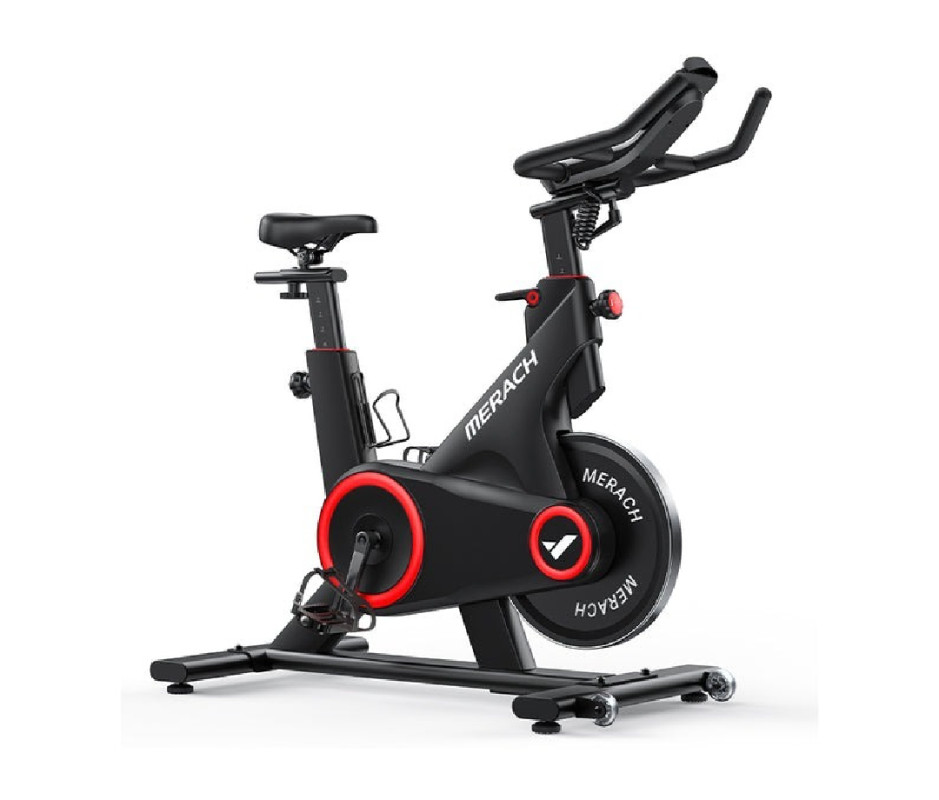
Courtesy Image
Merach’s S09 Indoor Exercise Bike gives you the most important features of the $4,000 bikes for less than $500. If you’re new to indoor cycling bikes, spending on the high end of the spectrum can be a pricey gamble, so the Merach S09 is a wallet-friendly way to test the waters. The 35-pound flywheel with electronically controlled magnetic resistance does a solid job replicating real-world riding and it’s nearly as quiet as the bikes from the big name companies. There’s no screen included which keeps the cost down and simplifies setup, but you’ll need to bring in a phone or tablet for virtual riding apps and there’s a phone/tablet holder built-in at eye level.
The bike has several tool-free fit adjustments that let you move the handlebars and seat fore and aft and up and down to get a comfortable fit and change the fit so multiple people can use the same bike. However, if you’re used to riding a nice outdoor bike, you may want to swap out the Merach’s pedals and seat for more performance options. The pedals have cages on one side and SPD clip-in cleats on the other. Likewise, the seat isn’t bad but will feel clunky if you’re used to slimmer saddles.
Importantly, the S09 played well with all the apps we used in testing. Zwift booted up and connected to the app with no hiccups and while you don’t get all the same features such as incline changes found in pricier options, the basic experience is there. There’s also the free Merach app which lets you get a taste of studio-style classes. It’s no Peloton app, but it’s not bad to mix into your routine and it’s a no-cost way to get started with apps. Hardcore riders may miss seeing their watts output, as the Merach just displays distance, cadence, time, and a calories burned estimate.
Might you like the $4,000 bikes better? Sure, but if you’re new to the category, this is a great starter bike to find out if you’ll stick with the habit and you can always upgrade to something shinier later. With registration, you get a two-year warranty, which is good reassurance for a budget bike.
- Flywheel weight: 35 pounds
- Resistance levels: 16
- Total weight: 95 pounds
- Built-in screen: No
Related: The Best Sport Watches for Every Type of Adventure
Best Exercise Bike for Spin Classes: Peloton Bike+
Courtesy Image
Peloton is the standard when it comes to studio-quality indoor bikes geared towards spin classes. While you can use the Peloton app with other bikes, only a Peloton Bike will let you compete on the Peloton leaderboards, and if you’re into Peloton classes, there’s no better bike to maximize your experience. Our tester felt that the bike itself, which includes an under-seat rack for lightweight dumbbells, was solid but that the software is what really makes the experience here.
Setting up these types of bikes can be a hassle if you’re operating solo or just not particularly handy, so we appreciated that Peloton sends a team with your delivery to bring the bike into your home and tackle all the assembly and initial setup. Fitting the bike is straightforward, but our taller tester wished you could adjust the reach on the handlebars instead of just the height. Likewise the large 24-inch monitor spins but isn’t otherwise adjustable to optimize your angle while riding. Clip-in pedals are included but you’ll need clip-in bike shoes if you don’t already own them, or swap in alternate pedals if you want to use regular shoes.
The Peloton app is front and center here and it stands out for the sheer breadth and depth of content available. There are thousands of classes on offer and not just for the bike. You can find instructor-led content for yoga, stretching, cardio, strength, running, Pilates, and more. Our tester noted that it’s easy to browse classes and find instructors and class types that fit your schedule and preferences. You’re locked into the Peloton app here, so no Zwift, TrainerRoad, or any of the other fitness or cycling apps while on the Peloton Bike+, but they include an entertainment mode that lets you play content from other apps such as Netflix, Disney+, and NBA League Pass while keeping your ride metrics in a helpful sidebar.
If you know you love Peloton classes already, picking up the Bike+ is a fairly easy choice despite the higher price for the bike and the $44 per month cost for their All-Access Membership. If you’re interested in Peloton but hesitant to make the investment, there are few ways to dip your toes in their pool. First, there’s a free tier to their app which will give you access to a small but representative sampling of their classes, even if you won’t be able to test it with the bike unless you live near their New York City studio. Luckily they also offer a risk-free 30-day trial of the bike. Peloton will deliver and set up the bike, you try it for up to 30 days, and if you decide it’s not for you, Peloton will refund you your cost including shipping fees and come pack up and take away the bike. Read our full review of Peloton Bike+.
- Flywheel weight: 38 pounds
- Resistance levels: 100
- Total weight: 140 pounds
- Built-in screen: Yes
Best Budget Peloton Alternative: Echelon Connect EX-5S-10 Bike
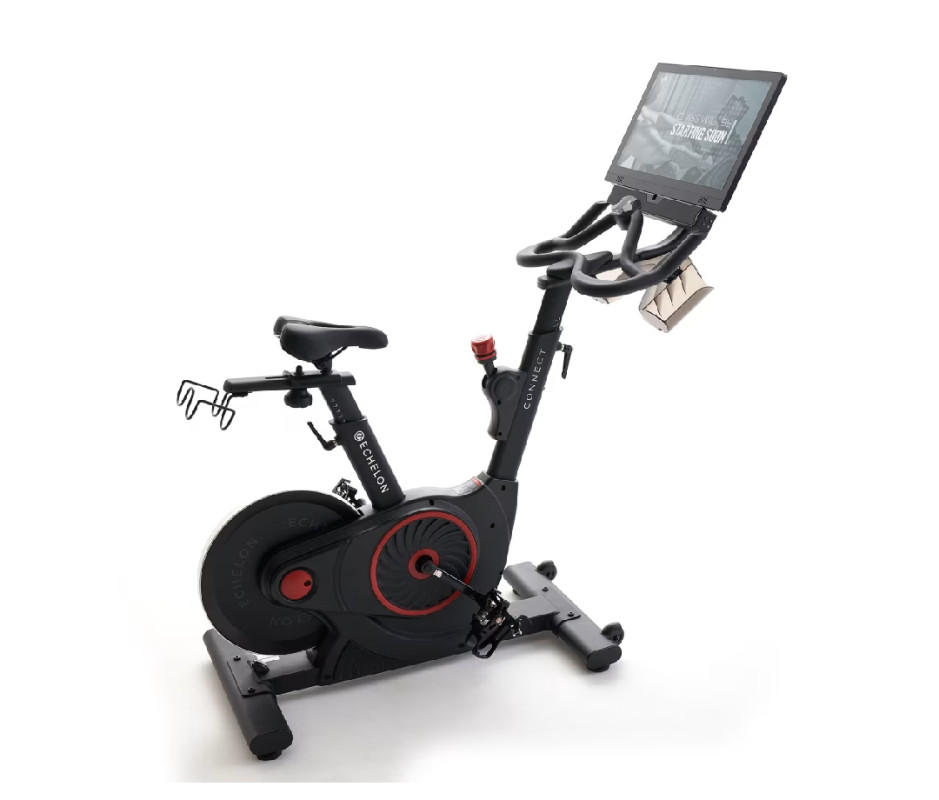
Courtesy Image
Peloton may set the standard for virtual fitness class libraries, but there are more options than ever in this space and many of them, like Echelon, come very close to matching the Peloton experience.
Echelon has thousands of classes, including live options to join and leaderboards to compete on, just like Peloton. They also have a diverse offering of off-bike classes, making the purchase of one of their bikes a more complete fitness solution than simply an at-home cardio machine.
Their Connect EX-5S-10 Bike can be had for about $500 less than Peloton base bike (and roughly $1,500 less than the Bike+), making it an attractive option for folks that want to get motivated by the social app-based class environment, but aren’t sure it’s worth it.
But is the Echelon bike and accompanying Echelon app any good? Our tester took advantage of the free 30-day trial and loved that there were plenty of options for choices in music, instructors, ability level, duration, and more. Unlike the bike, the cost for the app isn’t much cheaper than Peloton at $40 per month, but the savings on the bike versus the Peloton Bike+ could buy you several years of the Premier plan on the Echelon app. With the single subscription, you get up to five distinct user profiles, and our tester liked that he and his fiancee could share one subscription while still having distinct experiences.
Despite being a budget option, the EX-5S-10 comes with a 22-inch screen that’s large enough for easy viewing without making the bike top heavy or too much of a distraction in a room. Like Peloton, you’re locked into the Echelon app here so no Zwift or other fitness apps (no Peloton either, of course), but you can access music and a few other entertainment options.
Our tester discovered a backdoor that lets you load other apps such as Zwift and run them on the Echelon screen which gives you a lot more options for the bike. This light “hack” doesn’t require you to be a computer programmer, but it’s not exactly an approved use of the bike and there’s no guarantee Echelon won’t find a way to close this backdoor in the future.
In addition to the usual basics of RPMs, calories burned and the like, the bike also measures your power output in watts, a metric usually left out by budget bikes. This gives you a more objective riding metric to monitor and opens up more advanced cycling training rides that usually center around specific levels and oscillations of power output.
Overall, the Echelon Connect EX-5S-10 delivers most of what you get in a Peloton experience at a fraction of the cost. If you’re already a Peloton devotee, that might not be enough to sway you, but if you’re new to studio class-driven indoor cycling, Echelon is a great budget option to spin at home for less.
- Flywheel weight: 29 pounds
- Resistance levels: 32
- Total weight: 124 pounds
- Built-in screen: Yes
Best High-End Peloton Alternative: NordicTrack S27i Studio Cycle

Courtesy Image
It can seem like the Peloton bike is your only option if you’re looking for an indoor bike with a focus on studio spin classes, but there are actually a surprising number of options in this space, including NordicTrack’s S27i paired with their own iFIT content.
The bike itself features thick, easy-to-grip handlebars that make several riding positions possible and it also comes with decent pedals that have cages on one side and clip-in SPD pedals on the other. One feature not found on most other studio bikes is the incline adjustment that tilts the bike up and down to simulate grades from 20 degrees uphill and -10 degree decline. The gradients definitely changed the ride experience and added realism while following virtual road rides on the screen, but more minor slope changes obvious in the video weren’t always reflected in gradient changes on the bike and there was often a lag.
The screen is massive, which makes the virtual rides more immersive, though adjusting the screen position was sometimes a challenge. The downside in our tiny home was that it made the big feel like it took up much more space in our living room than the other bikes I tested and it made the S27i feel like the focal point of the room at times. Folks who have space in a home office or basement likely won’t be as bothered by this, but for those who keep their indoor bike front and center, it might be worth considering the NordicTrack S22i which is essentially the same bike with a smaller screen.
Like the Peloton bike, the S27i is a ready-to-ride, complete indoor biking solution that offers a magnetic resistance bike with under-seat 3-pound dumbbells and a very large built-in screen that runs the iFIT interface. Like Peloton, you’re locked into the iFIT environment, so while we’re reviewing bikes here, the iFIT membership is a key feature to consider if you’re looking at any of the NordicTrack bikes. iFIT pushes you towards the $39 per month family membership, but there is an individual membership for $15 per month that is plenty for your one bike if you’re the only rider or if you aren’t concerned with the app tailoring workouts to you.
Compared to Peloton, there aren’t nearly as many studio classes, but the production level is high, as is the energy of the instructors. I especially enjoyed the highly-produced, guided virtual rides that took me from Iceland to Switzerland to Thailand to Nevada in the span of a week. The instructors are knowledgeable and they share asides about the locations as well as training tips that enhance the experience. The number of virtual real-world rides is one of the biggest differentiators between iFIT and the Peloton platform. My partner who prefers studio classes to virtual rides liked the iFIT app and NordicTrack bike best of all the bikes I brought into the house for testing.
While this bike and the iFIT platform combination are a worthy Peloton alternative, I’d love to see NordicTrack add entertainment, like Peloton, or even better, allow third-party apps such as Zwift.
- Flywheel weight: 32 pounds
- Resistance levels: 24
- Total weight: 217 pounds
- Built-in screen: Yes
Related: 15 Best Cheap Tequilas to Enjoy on a Budget
More Exercise Bikes We Love
Best Exercise Bike for Small Spaces: Bowflex IC Bike SE
Schwinn and Bowflex are owned by Nautlius and you can see similarities between the Bowflex IC Bike SE and the Schwinn IC4 I reviewed, but the IC Bike SE stands out for its minimalist design that has a similar footprint to other bikes but is easier to store in cramped spaces thanks to the streamlined V design. There’s still a fairly wide base for stability, but there’s less frame down low so you can tuck it up against other furniture and it’s easier to wheel around a room for stowing away or bringing it out for a ride.
The bike itself is quiet and pedals smooth yet still has 100 levels of resistance, which at the high end can challenge all but the most hardcore cyclists. The seat isn’t hard like higher-end bikes and is a good option for multiple users in a household, though serious cyclists will probably end up swapping it for something more like their outdoor bike saddles. Similarly, the combination cage/SPD clip-in pedals work well for multiple users, but you can swap pedals for a minor additional cost to mimic you outdoor bike setup.
You get classic exercise bike stats such as calories burned, distance, and time, but I wish power (in watts) was captured as it’s a key stat for many of the cycling apps such as Zwift. That said, the IC Bike SE plays well with most cycling apps so you can enjoy virtual rides even if you might not get the same experience as more fully featured bikes with higher price tags. It’s also great for studio cycling rides and Bowflex/Schwinn has their own JRNY app which has lots of workouts tailored to their equipment as well as classes you can take without owning a bike or treadmill. I’ve noted before that I’m not much of a workout class person as I find I don’t need the interactivity to work out, but the JRNY workouts were well-produced and my class-loving partner enjoyed them.
The built-in 7-inch display is nice but I wish they would’ve used that screen to give you a tablet-like app interface instead of just an oversized display for your basic stats. Nearly half of the screen is devoted to a meter that shows your estimated calories burned. The small shelf above the screen works to place a tablet, phone, or even laptop, but I found that if I was really pushing hard, I could easily knock my device off since there isn’t a way to lock it in on the platform.
- Flywheel weight: NA
- Resistance levels: 100
- Total weight: 135 pounds
- Built-in screen: Yes
Best Smart Exercise Bike: Garmin TacX Neo Bike Plus
As a mountain biker that likes indoor training mostly to prepare for outdoor rides, I preferred the TacX Neo Bike Plus out of all of the bikes I tested. Along with the Wahoo Kickr Bike, this is as high-end as it gets when it comes to smart indoor cycling bikes, but the price buys you a lot of really nice features if you can afford it. When paired with Garmin’s TacX Training App, Zwift, and other apps, the bike becomes as close to a virtual reality ride experience as you can get in your home.
So how is this bike different than $500 options that seemingly operate in basically the same way? There are some obvious hardware features that stand out. The first difference I noticed is that there’s a virtual freehub, as on most outdoor bikes, which lets you coast for recovery on descents. On most other indoor bikes, if you try to coast (and you will if you ride outside), the pedals’ momentum will continue and whip your feet around. This may sound like a minor thing on paper but it adds a lot to the realism of your virtual rides.
Another surprisingly welcome feature is the simulated road feel. While not unique to the Garmin bike, this capability sends a diverse array of tactile vibrations through the bike when riding over virtual gravel, cobblestones, bridges, and dirt. When testing, I hadn’t read the features closely enough to expect it and was taken aback when I crossed my first wooden bridge in Zwift and found that it felt like I was crossing a wooden bridge. There are also built-in fans that can be configured to blow on you in proportion to your speed which helps cool you down and adds a little more to the realism. You can move the fans around as well if you don’t need them right in your face.
All that said, this is still a stationary bike. If you’re grunting out a climb outdoors, your bike rocks side to side and the Garmin doesn’t do that (yet). It also only simulates gradient virtually via resistance changes while many bikes including the Wahoo Kickr actually tilt your bike up and down which more accurately mimics the body and bike positions when gradients change. Having tested the dynamic incline feature on several other bikes, the omission here didn’t break my heart. I’ve found this feature fun when it works well, but it can lag behind the changes on-screen which breaks the virtual spell. For $4,000, it seems like something Garmin should try to tackle, but if it doesn’t work perfectly, I’d rather not have it at all.
You can pair the TacX Neo Bike Plus with the Garmin TacX Training app, Peloton, Zwift, TrainerRoad, and pretty much any cycling app on the market and Garmin seems to have put in the work to ensure smooth compatibility. The TacX Training app isn’t included and it’s optional to use with the TacX bike, but it offers virtual rides from around the world. These rides give you a first-person virtual view of the terrain and include simulated road feel feedback. I prefer these rides to hosted rides I’ve tried on other platforms where a guide leads you and talks the whole time. You simply experience the ride and can focus on the experience, though it might feel barebones to folks that prefer the interactions, badges, and other augmentations in virtual cycling worlds. You can also create and follow your own routes anywhere that Bing or Apple Maps cover, which isn’t quite as visually compelling, but can be a great training tool if you have a particular course you want to train for.
The biggest downside here is cost. The price tag is high and you’ll need to add pedals, app subscriptions, and a device for viewing virtual content at minimum. The costs mean that this bike isn’t realistic for any but the most devoted cyclists, but for those with the budget and the internal drive to get their money’s worth, the TacX Neo Bike Plus delivers the next best thing to riding outdoors.
- Flywheel weight: NA, virtual
- Resistance: 2,200 watts max
- Total weight: 110 pounds
- Built-in screen: No
Best Exercise Bike Under $1,000: Schwinn IC4 Indoor Cycling Bike
While the Schwinn IC4 technically retails for $1,300, it has been out for a few years now and can be had online from multiple retailers for well under $1,000, making it a great value option that fits both studio class enthusiasts as well as virtual cycling racers. It’s super-quiet and easy to use, making it an option for those just looking for an affordable bike to log cardio, with or without app enhancement.
For a budget bike, the substantial 40-pound flywheel provides plenty of magnetically controlled resistance via a front-and-center manual knob. Because it’s manual instead of electronic, you don’t get a data output or screen display of resistance and instead have to go by feel, or Rate of Perceived Exertion if you want to use the exercise parlance for “how hard exercise feels.” The pedals are fine, offering SPD clip-in or cage but you’ll likely swap these out if you have preferences from your outdoor bike. The seat is a nice surprise for a budget bike, offering a slimmer performance style build that’s not too cushioned but also not race bike hard.
You get all the usual stats such as distance, time, (estimated) calories burned, and RPMs, which is helpful when following along in spin classes. Probably the biggest omission is power, which is nice to have for many of the virtual riding apps and training programs though they will usually estimate watts based on the resistance. The backlit LCD display just gives you the basics, but there’s a phone/tablet holder for app viewing. Schwinn’s own JRNY app isn’t included, but it pairs nicely with the bike and you can use the generous 60-day trial to see if the classes fit your workout style.
The bike also has racks for the included 3-pound dumbbells incorporated into many of the studio classes. For larger guys like myself, such tiny dumbbells feel like an unnecessary bonus but they didn’t get in the way. Much more useful and surprising is the included heart rate monitor armband which transmits your heart rate data to apps and is a useful gauge of exertion in lieu of metrics such as wattage.
Compared to pricier bikes, the Schwinn IC4 keeps it simple and thus is able to keep the upfront cost reasonable. This would be a great first indoor bike for folks who aren’t sure they’ll become a dedicated enough stationary cyclist to justify spending thousands on an at-home cardio machine.
- Flywheel weight: 40 pounds
- Resistance: Manual, magnetic
- Total weight: 106 pounds
- Built-in screen: No
Best Exercise Bike for a Realistic Ride: Wahoo Kickr Smart Bike
My gym used to have a Wahoo Kickr Core trainer that I’d connect my mountain bike to (minus the rear wheel) that gave me my first taste of app-enhanced smart bike riding so I was excited to test Wahoo’s high-end indoor cycling bike. The Kickr Smart Bike works very similarly to the Garmin TacX Neo Bike Plus and if you’re shopping in this $4,000 stratosphere, you’re probably looking at one of the two.
The most glaring difference between the two is that the Kickr Bike has physical incline adjustments that tilt the bike (automatically to reflect virtual gradient changes in apps or manually). This feature isn’t a dealbreaker for me when comparing bikes, but Wahoo nails it on the Kickr Climb feature and it undeniably adds an element of realism to the virtual rides.
The bikes otherwise are extremely similar in ride feel and shifting, though some cyclists will undoubtedly find strong preferences between the two bikes. The other obvious differences are in the bike setups. The Garmin is more of a self-contained stationary bike while the Kickr Bike is more of a combination of optional accessories with a nice, streamlined bike that felt like it took up less room in our space. The fans that are built-in on the Garmin come as a sold-separately $240 Kickr Headwind fan that sits on the floor in front of you.
There’s no phone/tablet mount on the Kickr Bike either, but you can add the Kickr standing desk on which I’m of two minds. I loved running cycling apps on my laptop on the desk and found myself using it as a standing desk on it’s own, but the design makes the entire setup take up much more room than if the bike simply had a screen holder built-in. If space isn’t at a premium, it’s a great addition, but it’s definitely an addition when it comes to the footprint of your indoor cycling setup.
The Kickr Smart Bike itself is great and does the best job of any bikes I tested at replicating the feel of a real bike. I found it easy to fit and loved the form and aesthetics of the bike as well. It’s worth shouting out the Wahoo app’s Fit Wizard here as it definitely helped me get the bike dialed to my body and preferred riding position better than the other bikes. I didn’t have a professional bike fit to reference for this, but if you do, the Fit Wizard can use it to help you get an even more precise fit that mirrors your outdoor bike.
While I wasn’t able to test Wahoo’s new Kickr Bike Shift for this, it drops the Climb gradient adjustments and lowers the price by about $1,500, making it an attractive compromise for folks looking for a cheaper alternative with most of the bells and whistles.
- Flywheel weight: NA, electromagnetic
- Max resistance: 2,500 watts
- Total weight: 93 pounds
- Built-in screen: No
What to Look for in an Exercise Bike
Software
The indoor exercise bike market today is fractured by app subscriptions trying to capture your monthly dues. Varying compatibility between bikes and apps forces you to consider not only the bike you’re buying, but whether or not it works well with your favorite fitness apps.
Peloton is an instructive example. Their bike requires a $44/month software subscription, and if you enjoy their classes, their bike will give you the best Peloton experience, but it won’t connect with other programs such as the popular virtual cycling app Zwift. Other bikes offer the flexibility to connect with multiple different platforms, but you may lose certain features such as the ability to compete on Peloton’s leaderboards.
If you already know you love Peloton classes (or studio spin classes generally), you may not be bothered by being locked in to a single platform. (NordicTrack’s iFit platform is similar and their bikes are similarly limited to iFit content.)
But if you’re buying an stationary exercise bike for the first time and aren’t sure which platforms you like best, it’s probably smart to consider a more open-source option that provides access to several different cycling app environments before you commit hundreds, if not thousands, of your dollars to a single software platform bike.
If you’re bored by all this software talk and just want an indoor bike to ride for some exercise without more screeen time, we recommend you try one of the cheaper recommendations we make below as many of the features you pay for in the higher-end bikes are most valuable when using the bikes in conjunction with software and displays.
Related: 6 Killer Cycling Workouts
Realistic Ride Features
The Peloton bike is sometimes called a spin bike since it is used for studio classes, but all of the bikes we’ve reviewed here use the same basic design to replicate the feel of a real bike: magnetic resistance. The metal flywheel and magnets that control the resistance is why these bikes all weigh around 100 pounds. Other resistance mechanisms such as fans or friction don’t mimic real biking as well and are often loud, so most good indoor cycling bikes these days use some form of magnetic resistance.
Modern exercise bikes also have a range of other features designed to add realism to your stationary cycling experience. Bikes such as the Garmin TacX Neo Bike Plus transmit different types of vibration through the bike when riding over virtual dirt or cobblestones. Several of the bikes we review below mechanically adjust the tilt of the bike to simulate riding uphill or downhill. Many of the higher-end bikes we tested also come with road bike-style handlebars and mechanical shifters that can be configured in apps to work just like your outdoor bike.
If you’re training indoors for riding outdoors, many of these features will be exciting to you and not only help make training more realistic, but make your rides more engaging. If you’re simply riding indoors for fitness, they may just add cost and complexity that you don’t need.
Screens
If you’re planning to follow along with virtual rides or spin classes, you’ll need a device to run the apps and control the environment while you’re on the bike. Many of the studio-style exercise bikes like the Peloton come with a large built-in display screen and dedicated software, while most of the higher-end cyclist-oriented bikes have basic displays to show ride stats and force you to use your own tablet, computer, or phone for apps.
The easiest option for people that don’t want to fiddle with more tech than they have to is to use a Peloton or similar stationary bike where you have a permanent screen that’s dedicated to the native software platform. The trade-off for this convenience is often that your experience is limited to one app or platform for the life of your bike.
For folks who want more app flexibility but still want simple setup, using your smartphone is a straightforward option. Through our testing, we found that pairing exercise bikes and apps via the phone almost always worked more reliably and simply than other devices. The downside of a phone is the small screen size which can make it more difficult to read your stats and operate touchscreen button controls. Tablets are a close second in ease of use when bringing your own screen to the bike and have the benefit of a larger display. Many of the bikes we tested have built-in phone/tablet holders that make either a convenient heads-up display.
Laptops also make great display options, and they usually have plenty of horsepower for running graphics-intensive apps such as Zwift. Laptops can be difficult to mount on the bike, as the mounts on the bikes are usually built for phones and tablets. We also found that laptop and web-based apps were buggier when connecting and communicating data with the bikes. You can also use any of these devices to cast your favorite cycling apps to a TV for a larger, more immersive experience, but in our testing we found that smaller screens close to the bike were plenty. Casting the apps can also cause more interruptions and lags that make the environments less realistic. Running the apps from a computer or phone and then casting with Chromecast or Apple TV are your best bets if you want to ride with a big screen.
Why You Should Trust Me
I’m a recreational mountain biker these days, and I live for the thrill of the downhill and have always treated uphills as something to be endured to get the prize. Still, I’ve come around to appreciating how endurance training can help me enjoy the entire ride outdoors and I’ve even (tell no one) occasionally found myself enjoying the uphill suffering. For this article, I tested each of these bikes for several weeks and rotated them through other riders as well to make sure my personal biases didn’t color my reviews too much. Several other Men’s Journal editors and writers also chipped in by testing some of the stationary bikes featured here.

